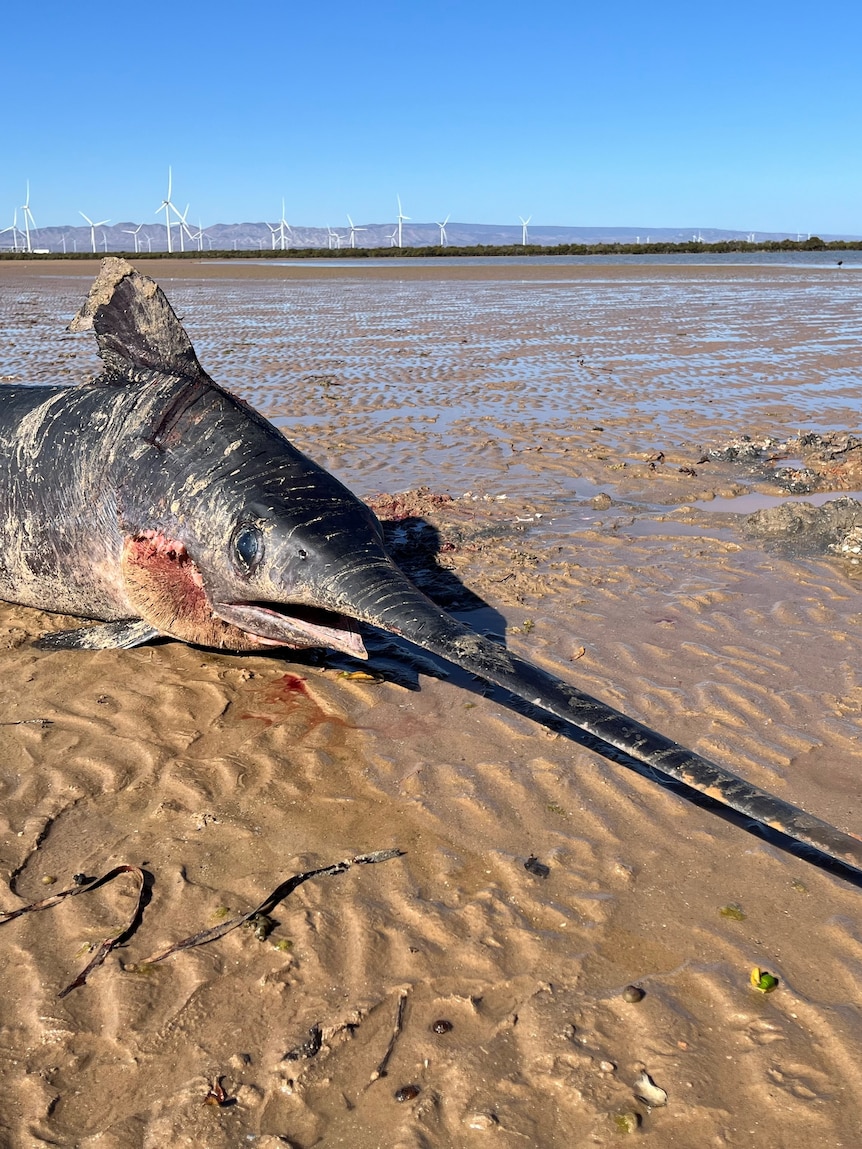Mark Drummond was taking a stroll along Port Paterson beach near Port Augusta with his dogs on Saturday when he spotted “a black lump” in the distance on the mudflat.
“I thought it might have been a dead dolphin,” the North Stirling local said.
“When I got out there, it was a real surprise.
“I didn’t know what it was, if it was a swordfish or a marlin … but I found out it’s probably a swordfish.”
Mr Drummond said he made sure his photos of the swordfish included his dogs so that people could better appreciate the size of the creature from the deep.
“It was probably 100, 120 kilos and dwarfed my dogs, especially the little Tenterfield terrier — he looked tiny near it,” he said.
“I reckon [it was] two and a half, nearly three metres.”
Mr Drummond said even though he fished regularly he had only seen a fish like that on television.
“We don’t see it locally, no, never really seen anything like it, especially not up close,” he said.
“It’ll be once in a lifetime.”
‘A very rare occurrence’
Professor of Sustainable Marine Research Collaboration at University of Tasmania Sean Tracey said swordfish were normally found on Australia’s east and west coasts, especially in commercial fisheries, and in very deep waters.
“That is a very rare occurrence to see swordfish up in Port Augusta,” he said.
“They’re usually a species that lives out off the continental shelf.
“From satellite tagging work we’ve been able to identify that each day they will migrate during the day to about 300 to 600 metres deep and at night come up to the surface.
“So for a swordfish to be not only in a gulf, but right up in the shallows of the gulf — I would suggest it was quite lost.
“They get lost in currents and up in areas where they’re less familiar with.
“It looks like it’s on a large mudflat, a tidal mudflat as well.
“It could have got stuck in that shallow water, and the tide’s gone out and it’s basically been beached.”
‘Last frontier’ for fishers
Professor Tracey said he would be interested to find out if the beached fish was from the east or west, but that required taking a sample for a genetic test.
“[Swordfish in the east and west of Australia] look exactly the same — it’s purely a genetic difference, which would suggest they’re not breeding, so they’re not intermingling,” he said.
“Which, again, makes that south coast population the big unknown of what’s going on with fish in that area.”
Professor Tracey said some fishing fanatics cast swordfish into moulds because they were such a coveted catch.
“It is quite uncommon to find swordfish in the Great Australian Bight,” he said.
“That kind of makes them the last frontier for some recreational fishers … it’s kind of seen as the pinnacle of game fishing — they’re a very difficult species to capture.
“I do know a few recreational fishers in South Australia have gone out and tried, and I believe that there was one caught – I think it was accidentally – off Port Macdonnell a few years ago.
“The challenge is they have to go so far out to sea to actually get over the shelf break in most areas.”
Port Augusta City Council said it had notified the SA Museum and the Department of Environment and Water, but the council will not be taking any action in relation to the fish.
Posted , updated




